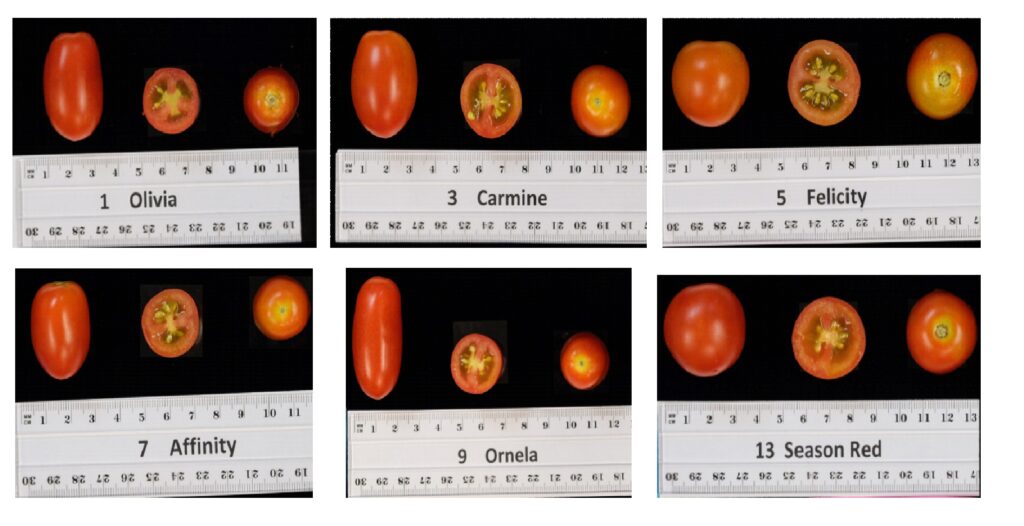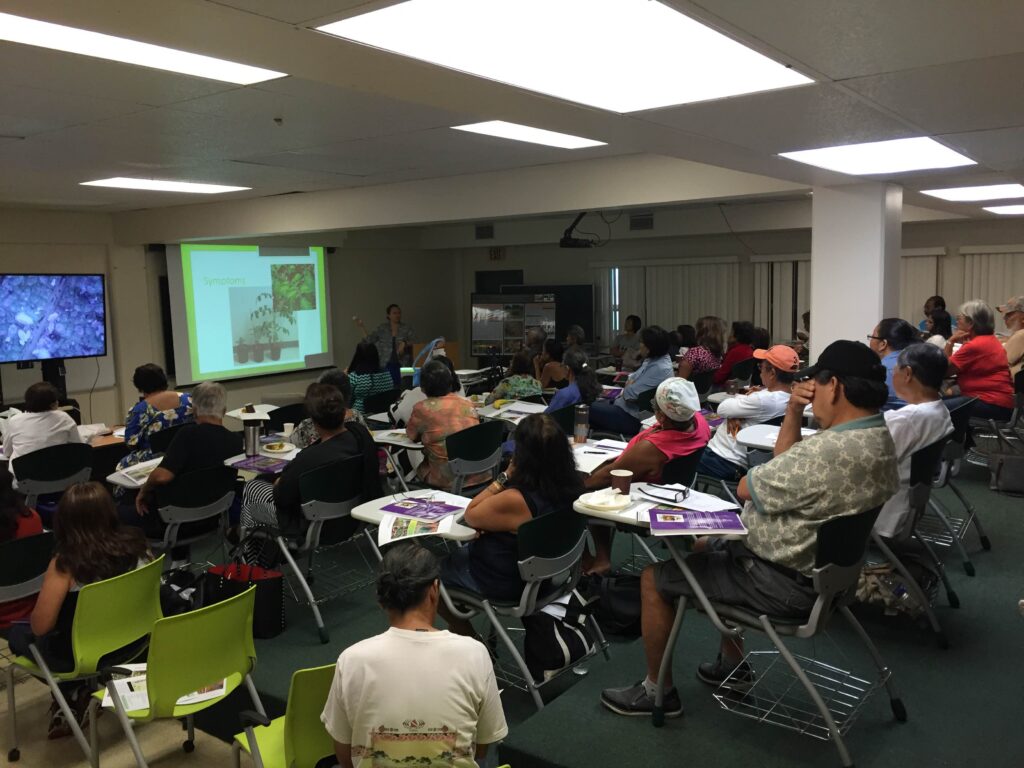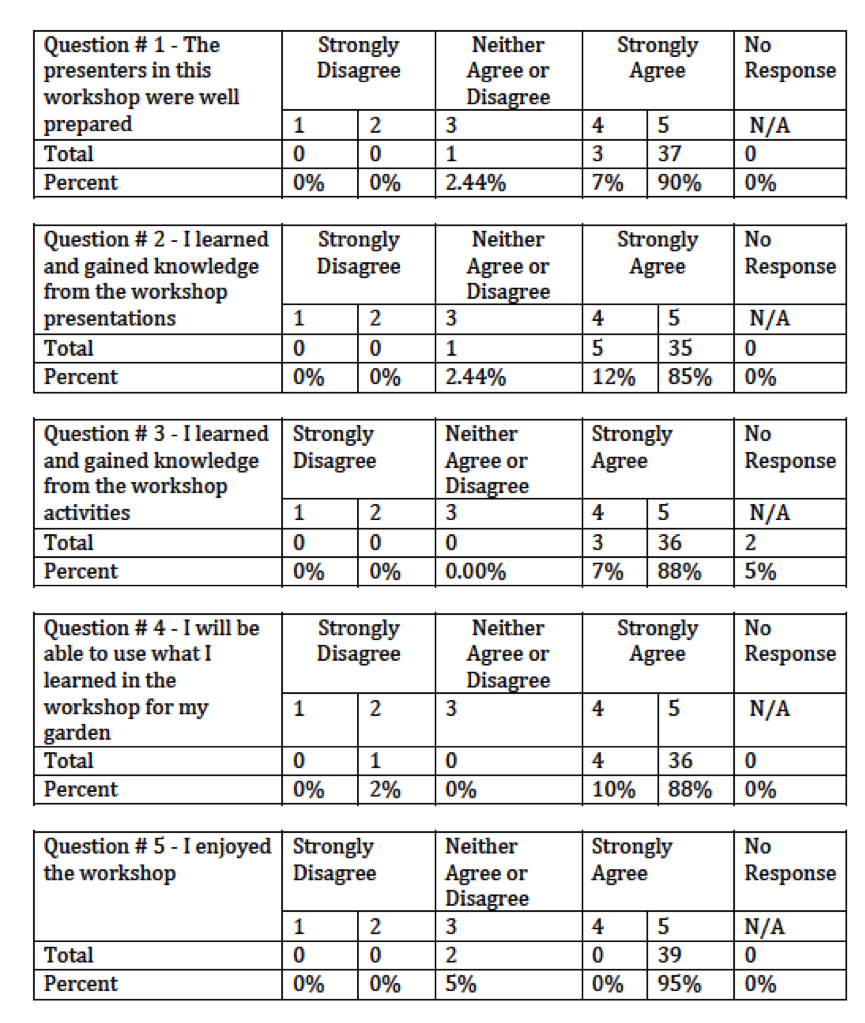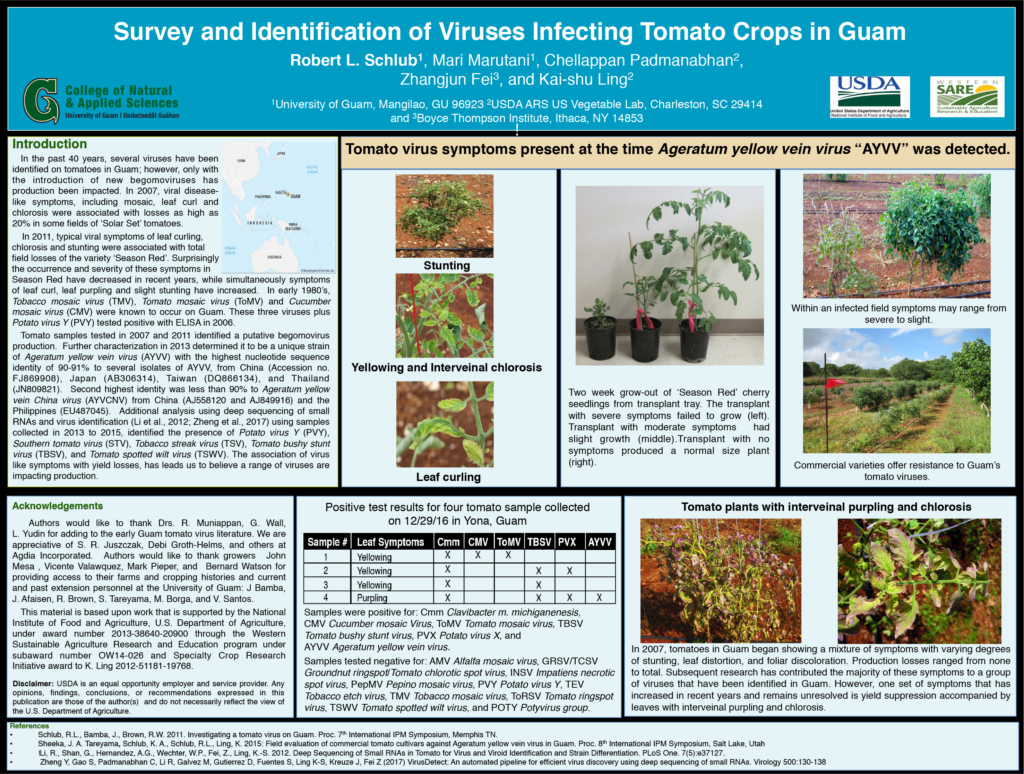Final report for OW14-026
Project Information
The project “Screening tomato varieties for suitability on Guam in response to the arrival of Tomato leaf curl Guam virus in the Western Region” was completed over a three-year performance period and a no-cost extension period. This project centered on reducing the impact of this virus on Guam through the introduction of resistant tomato varieties among growers, the elimination of chemicals by farmers to control the disease through controlling whitefly population, and finally the return of the economic vitality of growing tomatoes on Guam.
The need for this project arose after tomato growers in northern Guam began abandoning production due to yield losses attributed to Tomato leaf curl virus. An island wide survey conducted in July 2013 confirmed the presence of the virus in half of Guam’s farming areas and validated that the virus was in fact responsible for the losses reported earlier by farmers. The research approach used in this project was one of farmer engagement; thereby, giving some growers an incentive to continue producing tomatoes even though Guam’s preferred tomato variety was suffering yield losses.
In the first year of the project the groundwork was put into place, meanwhile the virus was confirmed to be a strain of Ageratum yellow vein virus (AYVV) unique to Guam rather than Tomato leaf curl Guam virus (TLCGV). The 5 participating producers were trained and educated on recognition of virus symptoms and on how the variety trial would be conducted. Producers reviewed the characteristics of 40 varieties, prepared by the project graduate student and PI, and then selected 17 varieties for inclusion in the variety trial. The wet season trial was completed in December 2014, at which time the 5 participating farmers visited each test plot and selected the top varieties. Results from the wet season varietal trial were presented in a poster at the 8th International IPM Symposium on March 2015, and included in the 2016 revision of the “Eggplant, Pepper and Tomato Production Guide for Guam.”
In the second year of the project the dry season variety trial was planted, unfortunately it was discontinued after the passing of Typhoon Dolphin. In its place another variety trial was conducted, this time using the top 5 varieties identified by the farmers at the end of the dry season. A producer and professional field day was held on October 21, 2015 where participants examined plots and provided variety recommendations. The project was highlighted in the 2015 annual impact report for the College of Natural and Applied Sciences.
In the third year, a workshop was held for 55 farmers and home gardeners at the University of Guam where the results of this project’s tomato virus resistance variety trial were presented. In an attempt to unravel the cause of tomato leaf purpling, symptomatic leaf samples were sent off-island for DNA analysis; it was determined that Guam’s tomato crops are suffering from a complex of virus diseases and a bacterial disease. An Ageratum yellow vein virus brochure was distributed at meetings of the Guam’s Farmer Cooperative Association, and Guam’s Northern and Southern Conservation Districts.
The project’s no-cost extension period allowed for the completion of several items: the tomato virus YouTube video; the inclusion of the list of known tomato virus on a 2017 APS Caribbean Division poster, “Plant Diseases of the Western Pacific Tropical Island of Guam”; the presentation of the poster, “Survey and Identification of Viruses Infecting Tomato Crop on Guam” at the 2017 annual meeting of the American Phytopathological Society in 2017 in San Antonio, Texas; and the completing of the project’s final report.
The goal of this project was to return tomato production on Guam to the levels preceding the impact of AYVV (formerly identified as TLCGV). With the completion of our project, tomato grower profitability will improve as growers adopt the recommendations covered in the workshop and the 2016 updated “Eggplant, Pepper and Tomato Production Guide for Guam.”
Over the course of this project, three specific and measureable objectives were completed.
Objective 1 (Year 1): Improve the ability of producers to screen tomato varieties for Tomato leaf curl Guam virus (TLCGV) resistance and suitability for production on Guam.
Activities for Objective 1: (1) After consulting with project statistician, PI met with producers and provided instruction on virus identification and scoring tomato varieties for resistance to AYVV and suitability for production on Guam. (2) Producers were given pre- and post-tests to measure knowledge gained. (3) Producers reviewed the characteristics of 40 varieties prepared by the project graduate student and PI and selected the 18 varieties that would be included in the trial. (4) PI and graduate student assisted each producer with a wet season variety screening trial. (5) Producers hosted a producer field day and members reevaluated the plots. (6) Producers begin a dry season variety trial but it was terminated due to damage from Typhoon Dolphin. As a replacement, a smaller trial consisting of the local preferred susceptible variety Season Red and 5 resistant varieties were planted. (7) Producers hosted a 2nd producer field day and members evaluated the plots. (8) Project statistician ran a MANOVA of the response variable data on some of the dry season trial data and interpreted the screening trial results for PI and producers.
Objective 2 (Year 2): Bring awareness to producers and the public about Guam’s whitefly transmitted tomato virus and steps that can be followed to reduce its impact.
Activities for Objective 2: (9) PI and producers hosted a workshop onsite at one of the variety trial locations for the island’s farmers, home gardeners, NRCS and the Department of Agriculture. After the workshop, an outreach survey was conducted similar to the one posted on the SARE program website. (10) Information presented in the public workshop was included in the 2016 revision of the “Eggplant, Pepper and Tomato Production Guide for Guam” and in a brochure on AYVV produced by the project graduate student. (11) A YouTube video was created about AYVV.
Objective 3 (Year 3): Bring about the adoption of farm practices that will reduce the occurrence of TLCGV in tomato fields and result in produce production returning to pre-Tomato leaf curl Guam virus levels.
Activities for Objective 3: (12) The project’s graduate student distributed AYVV brochures at meetings of the Guam’s Farmer Cooperative Association and Guam’s Northern and Southern Conservation Districts. (13) Impact of the project on tomato producers.
Cooperators
Research
The experimental design used in this project was a random block design, consisting of 18 varieties as the independent variable, 4 farms as the blocking variable, and multiple response variables were yield quality, Brix reading, presence of disease and profitability. In each farm, 18 varieties were randomly assigned to 18 plots, and each cultivar had five plants within the plot. The experiment was to be conducted twice, once during the wet season and once during the dry season, however no data was collected from the dry season due to damage from typhoon Dolphin. Since multiple response variables were used, a MANOVA was performed to reduce the chance of committing a type I error.
The experimental design for the wet season trial consisted of the planting of Guam’s standard variety ‘Season Red’ and 17 test tomato varieties on 4 farms. A field consisted of three 100ft rows among which groups/plots of 5 plants of each of the 18 varieties were scattered (randomized). Plant spacing was 31 inches with an extra 24 inches between plots, and the row spacing was 6ft. A single row of the variety Season Red was used as a border and as an indicator of the amount of virus on the farm.
The dry-season variety trial began in February 2015 with the same experimental design as the wet season trial to compare 17 commercial tomato varieties for virus resistance and production suitability against the control variety ‘Season Red’. Variety trials were severely affected by the arrival of Typhoon Dolphin to Guam on May 2015, resulting in the termination of the dry-season variety trials. In June 2015, a final variety trial was conducted with the same experimental design as the first two trials to re-evaluate the top 5 varieties identified in the 2014 wet-season variety trial.
Producers were involved throughout the grant process. Involvement began with variety selection. They assisted with transplanting and maintained the plots according to the updated Eggplant, Pepper and Tomato Production Guide For Guam (http://cnas-re.uog.edu/media/pdf/E/g/g/Eggplant-Pepper-and-Tomato-Production-Guide-on-Guam-2nd-E-Web.pdf). Producers were also responsible for rating the varieties based on disease resistance and fruit marketability.
Various molecular methods were employed to identify the specific virus species present in Guam’s tomatoes: nucleotide sequence identity, deep sequencing of small RNAs identification, sequence analysis using BLASTn, and PCR amplified (~1,100 bp) products.
The research results from this project will support the return of tomato production on Guam to the levels preceding the impact of AYVV (formerly identified as TLCGV), therefore improving tomato grower profitability.
In the first year of the project the partial analysis of variety resistance identified 12 varieties with virus resistance superior to ‘Season Red’ and five with inferior resistance. Those varieties with superior resistance include: 3, 9, 12, 7, 1, 4, 5, 14, 11, 15, 10, and 17, while 16, 6, 18, 8, and 2 were identified as inferior to ‘Season Red’ (refer to Table 1 for the corresponding variety name for each field ID).

Based on Real-time PCR of pooled samples, AYVV was detected in one superior variety and four of the inferior ones. When symptomless tomatoes were tested, only one of the 18 varieties were positive for AYVV. Figure 1 illustrates the fruit types of the selected varieties, which were grape, cherry, globe, or oval fruits. In a separate replicated trial planted on October 2014, plants again exhibited AYVV symptoms; however, Real-time PCR analysis showed low frequencies of the virus. This may indicate the presence of another virus affecting tomato production.

Figure 1: Fruit types of varieties selected by producers, compared to ‘Season Red’
In the second year of the project, the three varieties selected by the producers from the final variety trial (‘Carmine’, ‘Tylon’, and ‘Ornela’) were recommended for production on Guam based on their strong virus resistance, high yield and low levels of unmarketable/cracked fruits. The variety ‘Olivia’ was recommended for production during Guam’s dry-season or in a greenhouse or hoop-house.
Other viruses identified from real-time PCR samples indicated viral infection was more complex than what was previously thought. As a result it is recommended that further tomato variety trials be conducted to identify varieties with resistance to secure local tomato production on Guam.
In the third year of project the field observations and analysis of the four new samples by Agdia Inc. in December of 2016 there was a raise in the possibility that the level of AYVV in Guam’s fields is decreasing while production is still being depressed. The failure of ‘Season Red’ to return to pre-AYVV levels is still unresolved however may be due to a complex of viruses along with the bacterium Clavibacter m. michiganensis. More research needs to be done in this area.
Research Outcomes
Education and Outreach
Participation Summary:
In the first year of the project the educational and outreach activity was a poster presentation.
- The results from the wet-season variety trail which began in August 2014 with the comparison of 17 commercial tomato varieties for virus resistance and production suitability against the control variety ‘Season Red’ were presented in a poster at the 8th International IPM Symposium (Figure 1) on March 2015.

Figure 1: Tomato virus variety trial poster, results from the wet season variety trial. http://cnas-re.uog.edu/media/pdf/T/o/m/Tomato-Virus-2015-Poster.pdf
In the third year of the project the educational and outreach activities were as follows:
- A workshop was held on August 06, 2016 at the University of Guam, College of Natural and Applied Sciences building concerning the results of this project. Fifty-five farmers and home gardeners attended.
The workshop began with welcoming remarks, and the distribution of useful handouts such as the latest version of the Eggplant, Pepper, and Tomato Production Guide for Guam (a publication from a previously funded WSARE grant) as well as a pre-test. Mr. Jim Hollyer, Associate Director of Extension & Outreach welcomed the participants with a short presentation on Extension’s role in the community. Dr. Robert Schlub, the Project Coordinator for this grant gave a short overview of the project. Ms. Sheeka Tareyama, an Extension Associate working on the project then followed with her presentation, which included a producer evaluation of the variety trials (Figure 2). The presentation can be found online at the following link: https://drive.google.com/open?id=0By5n4w26eOwGVGZGNTZlSnZKZk0
Pre and post-tests were given to 55 farmers and home gardeners at the workshop. Pre-test scores averaged 40%, while the post-test scores average was 85%. This showed a significant gain in knowledge. Also, the results of the workshop evaluation questionnaire (Table 1) showed that the workshop was a success.

Figure 2: Extension Associate Ms. Sheeka Tareyama discusses the results of the WASRE Professional Producer funded tomato virus resistance variety trial with 55 Guam farmers and home gardeners.
Table 1: WSARE funded tomato virus variety trial workshop evaluation scores.

- Ageratum yellow vein virus (AYVV) brochures were distributed at meetings of the Guam’s Farmer Cooperative Association, and Guam’s Northern and Southern Conservation Districts.
In the no-cost extension period the educational and outreach objectives were as follows:
- YouTube video “Symptoms of Guam’s Ageratum Yellow Vein Virus (AYVV) on Tomato” is a 10-minute video created from WSARE Professional Producer project reports, materials created during the project such as posters, publications and an informative brochure/factsheet, and from footage of a presentation by the graduate student who assisted the PI with the initial work of the project. Several meetings with the project’s PI took place in order to determine the videos content. The planning period ended with the creation of the video’s storyboard on the Microsoft PowerPoint software.
A portion of the footage recorded on August 2016 of Extension Associate Sheeka Tareyama during her presentation on AYVV at the workshop for Farmers and Home Gardeners was used in the YouTube video. Adobe suite software premier pro was used to edit the footage into a cleaner version for use in the video.
The actual creation of the video began after the final version of the storyboard was approved and the AYVV presentation video was edited. The content and animation sequences for the video were done by using the following Adobe software: Photoshop, Illustrator, Encore, Media Encoder and After Effects. The parts of the video were then edited together with Adobe Premier Pro.
There were five versions of the video that were reviewed by the PI before being updated by the Extension Associate. The final draft for review was sent to collaborator Dr. Ling, USDA Agriculture Research Service. The final version of video is available for viewing at: https://youtu.be/-c9eOvGSgJk
- The Survey and identification of viruses infecting tomato crops in Guam poster abstract (see below) was presented at the 2017 APS Annual Meeting on August 5-9, 2017 by the PI. The poster (Figure 3) contained all information gathered during the project by the PI and the project team as well as all the collaborators of the project. A portion of this information was included in a poster presented at the 2017 APS Caribbean Division meeting in Costa Rica, “Plant Diseases of the Western Pacific Tropical Island of Guam” (http://cnas-re.uog.edu/media/pdf/D/i/s/Disease-Poster-Version-9.pdf )
Abstract: Survey and identification of viruses infecting tomato crops in Guam
Robert L. Schlub, Univ of Guam, Mangilao, AP, Mari Marutani, University of Guam, Mangilao, AP, Chellappan Padmanabhan, USDA ARS US Vegetable Lab, Charleston, SC, Zhangjun Fei, Boyce Thompson Institute, Ithaca, NY and Kai-shu Ling, USDA ARS, Charleston, SC
The impact of viruses on Guam’s two major tomato varieties ‘Solar Set’ and ‘Season Red’ has crippled production on the island. In 2007, viral disease-like symptoms, including mosaic, leaf curl and chlorosis were associated with losses as high as 20% in some fields of Solar Set. In the spring of 2011, severe symptoms of leaf curling, chlorosis and stunting were observed in Season Red, resulting in a total loss on some farms. In early 1980’s, Tobacco mosaic virus (TMV), Tomato mosaic virus(ToMV) and Cucumber mosaic virus (CMV) were known to occur on Guam. Tomato samples tested in 2007 and 2011 identified a putative begomovirus. Further characterization in 2013 determined it to be a unique strain of Ageratum yellow vein virus(AYVV) with the highest nucleotide sequence identity of 90-91% to several isolates of AYVV, from China (Accession no. FJ869908), Japan (AB306314), Taiwan (DQ866134), and Thailand (JN809821). Second highest identity was less than 90% to Ageratum yellow vein China virus (AYVCNV) from China (AJ558120 and AJ849916) and the Philippines (EU487045). Additional analysis using deep sequencing of small RNAs and virus identification using samples collected in 2013 to 2015, identified the presence of Potato virus Y (PVY), Southern tomato virus (STV), Tobacco streak virus (TSV), Tomato bushy stunt virus (TBSV), and Tomato spotted wilt virus (TSWV). Our surveys reveal that in recent years a range of viruses were involved in causing losses to tomato crops in Guam.

Figure 3. Survey and identification of viruses infecting tomato crops on Guam poster: http://cnas-re.uog.edu/media/pdf/P/O/S/POSTER_Survey-and-identification-of-viruses-Final-07072017.pdf